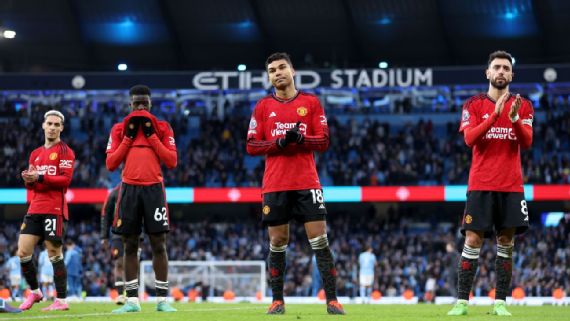Soccer is the fairest sport of all — in theory.
Major League Baseball involves a 162-game regular season, but then the winner gets crowned via a postseason that requires the champions to play, at most, 22 games. In the NBA, there are 82 games in the regular season — then a maximum of 28 playoff games to win it all. And in the NFL, you get 17 games in the regular season and as many as four to lift the Super Bowl trophy.
None of those structures is really suited to identify the best team — rather, just one of the best. Playoff champions are frequently decided by a combination of on-field luck, mistimed injuries and favorable scheduling.
In soccer, though, every game is a playoff game and every team plays the exact same schedule. We add up the points at the end of it all: if you have the most points, you win, and if you have the fewest, you get relegated. It’s as meritocratic as it gets.
Well, it should be. But it’s not. Unlike the other sports, which have financial regulations designed to save the owners money — er, sorry, designed to keep everyone’s spending at similar levels and promote league-wide parity — soccer doesn’t have that.
Per Deloitte’s most recent accounting, Real Madrid brought in more revenue — €831.4 million — than any other club in the world. In Spain, Barcelona weren’t far behind at €800.1 million, but then you drop all the way down to €364.1 million for Atletico Madrid in third and €214.3 million for Sevilla in fourth. Big clubs have the ability to spend multitudes more than their smaller competition — it just isn’t a fair fight.
So, today, we’re going to come up with a way to estimate which teams are getting the most, and the least, out of how they spend their money. We’re looking at all 96 teams across Europe’s “Big Five” top leagues and ranking them by how much they’re over- or underperforming the money they’ve spent on their own squad.
With this 96-team ranking, let’s separate the clubs getting the most value out of their payroll spending from those basically shooting wads of cash at their roster like one of those T-shirt guns.
Finances in European soccer are purposefully opaque. See: what’s going on with Nottingham Forest, Everton and Manchester City, who have all been under slow-going financial investigations. And so, precise spending on transfer fees and wages for the current season isn’t available, and won’t ever be.
For this exercise, then, we’re going to rely on the wage data provided by the site FBref. A good chunk of the data is estimated, but the numbers are directionally correct. For now, they’re the best we’ve got.
So, how to determine the rankings? First, I’ve calculated the average wage money spent per point won for each league so far this season. Then, I divided that number by the number of games played in each league to normalize the numbers across all leagues. Then, I did the same thing for each club, and compared that number to each league average.
Why not just look at all of Europe together? These teams aren’t competing against opponents from other countries when they play in their own leagues. Plus, English clubs are so much richer than all of the others that they would almost all rank toward the bottom when you compare their spending to the Europe-wide average. Remember, we’re trying to identify teams which get the most value out of their spending, and it simply costs a lot more to be competitive in the Premier League.
To come up with the final order, I ranked every team by two similar metrics: 1) the raw number of how many dollars per point they were below their league average, and 2) how many percentage points below their league average they were. Then, I combined each team’s ranking across both metrics and created the final list.
The result is a ranking of all 96 clubs across Europe’s Big Five leagues, starting from the smartest and most efficient spenders, all the way down to the worst and most wasteful spenders.
Per FBref’s estimates, the newly promoted German club have the third-lowest wage bill in all of Europe. German teams are spending about $58,000 per game per point this season — the second-biggest number in Europe. That puts Heidenheim’s spend per point about 73% below the Bundesliga average, which is easily the best mark of any team in Europe.
They’re currently in 11th place — 10 points clear of the relegation places with just eighth games left to play. But the underlying reality of their performance mirrors the reality of a team with their spending power. They’ve scored 33 goals from 28 expected goals and conceded 37 goals from 41 expected. You can outperform your fundamentals for a season, but it’s going to be really hard to do it two years in a row.
Alavés have outperformed in the way we typically expect lesser-off teams to do: with their defense. Effort and organization can create an above-average defense, but to score lots of goals, you need great attackers, and great attackers cost a ton of money.
Under manager Luis García Plaza, Alavés play the second-fewest passes of any team in Spain and move the ball upfield faster than anyone else. But despite conceding so much of the ball, they’re allowing only the seventh-most shots of anyone in Spain. Incredibly, they also have a positive expected-goal differential despite what FBref estimates to be the lowest wage bill in the league.
If it weren’t for Xabi Alonso’s Bayer Leverkusen, we’d probably be talking a lot more about Stuttgart. Comparing underlying numbers across leagues gets a little tricky, but just check out where Stuttgart sit on this plot:
Under 41-year-old manager Sebastian Hoeness, they’ve created and conceded chances about as well as the likes of Liverpool, Manchester City and Barcelona have done in their own domestic leagues this season. And it’s not just the underlying numbers, either. Only 10 teams in Europe are averaging more points per game than Stuttgart, who, per FBref’s estimates, have the 65th-biggest wage bill on the continent.
It seems like only a matter of time until Hoeness becomes the next hot manager candidate among all of the big clubs.
Another way to overperform: be weird. Las Palmas are managed by Garcia Pimienta, who was the Barcelona B manager for three years prior. And you can see it: although they have limited resources, Las Palmas average the third-most passes of any team in LaLiga, and they also allow the second-lowest opponent pass-completion percentage. The only team ahead of them in both metrics: Barcelona.
Despite dominating the ball and pressing, they’re using what might typically be understood as attacking tactics to defend. They’re a terrible attacking team, actually. They barely take any shots and most of those they attempt are from long range, but they also concede fewer than 10 shots per match, and that has led to 32 goals allowed — tied for fourth best in the league.
Much like with Heidenheim, though, the warning signs are there for next season. Las Palmas have the second-worst xG, or expected goals, differential in LaLiga.
Perhaps there should be a tiny asterisk: look at these scrappy underdogs who are part of the same multi-club ownership group as Manchester City! But that shouldn’t undermine the unlikelihood of Girona’s performance this season, nor should the inevitable slump that they’ve hit over the past couple of months. Now down to third in the table, they still have a six-point lead on fourth-place Athletic Bilbao and a seven-point lead on fifth-place Atletico Madrid.
More importantly, they’re just fun. They’re fourth in the league in expected goals created and 12th in the league in xG allowed. A defensive approach certainly raises the floor, but Girona’s attacking tilt is what allowed them to seriously challenge Real Madrid for nearly two-thirds of a season.
To put things into perspective, let’s just compare the leagues, based on dollars spent per point per game so far. Remember, these are rough estimates:
• Premier League: $103,661
• Bundesliga: $58,584
• LaLiga: $50,561
• Serie A: $47,203
• Ligue 1: $40,656
Put another way: Luton Town have the lowest wage bill in the Premier League by far, and they play in a 12,000-person stadium you can access by walking through some guy’s apartment — but they still pay their players more than 34 of the 96 teams in Europe.
Given the discrepancy within their own league, though, it would have been a massive success for Luton to just not finish dead last in England’s top flight. And if they do stay up — they’re currently in 17th, one point clear of 18th — it’ll basically be a miracle. Bigger clubs are bound to give manager Rob Edwards a look this summer.
The current answer to my favorite trivia question of the 2023-24 season: who is in second place in France?
In fact, Brest are getting more performance out of their spending than any other team in Europe: $12,481 per point, per game. The main reason they’re not first on the list is that, on average, teams in France are spending much less than those in any of the other leagues. On top of that, they’re not your typical second-place team. They’re averaging 1.81 points per game — which is less than the fifth-place teams in Germany, Spain and England, and less than the fourth-place team in Italy.
They’re the last of LaLiga’s midtable overachievers. Unlike the other two sides, they’re doing it by being, uh, completely nondescript. They’re an average-ish defensive team, and their attack is pretty much dependent on their 6-foot-3, 32-year-old Croatian striker Ante Budimir doing something while the ball is in the air. He has scored 15 goals and added two assists this season. That’s more goals+assists than the next four players on Osasuna, combined.
And finally, one of Europe’s true Moneyball teams.
As I wrote about over the fall, the previous ownership group, which included the real-life star of “Moneyball,” Billy Beane, had to renounce its connection to the club because Toulouse won the French Cup last season. That was a problem because the same group now owns AC Milan, who qualified for the Champions League, and that was in violation of UEFA’s multiclub ownership rules, which essentially say you can’t own two teams who are in Europe at the same time.
But Damien Comolli, the guy who was supposed to bring Moneyball to Liverpool, is still in charge. And Toulouse are still the youngest team in France. They really struggled with juggling the extra Europa League matches in the first half of the season, but since December, the attack and defense have both steadily improved.
Our first Italian team — why is no one higher?
To start with, Italy doesn’t have the same kind of massive financial gap between the top and bottom teams that we see in every other league. We’ve already been over Spain. Paris Saint-Germain lord over France, Bayern Munich drastically outspend the rest of Germany and then there’s the “Big Six” in England that sit at the top. Juventus, Inter and even Roma spend a lot of money on players, but not to the same degree.
And then it goes the other way, too. The teams towards the bottom of France, Germany and Spain tend to spend less on salaries than the bottom teams in Italy do, according to the FBref data. Because of all that, Italian teams just don’t really stand out as outliers amidst this methodology, in either direction.
With Lecce, though, it’s pretty simple. They have the lowest wage bill in the league, and they’re in 13th place.
Thiago Motta’s team is fourth in the Serie A table, overachieving in a way you don’t normally see teams overachieve: by being deliberate and incredibly slow. Bologna average the second-most passes of any team in Italy, and they move the ball upfield at 1.03 meters/second — the slowest rate in the league.
I promise I didn’t rig this — they just happened to be right next to each other in the rankings. Why are they here? I’ll leave that to Ian Graham, Liverpool’s former head of research:
The thing that really interested me was how little the Liverpool model has been successfully adopted. So which teams have successfully adopted the Liverpool model? Brighton and Brentford: what do those two teams have in common? From the top, it’s data-driven strategy — everyone has to answer to the evidence, and if they’re not answering to the evidence, they’re out. Brighton and Brentford were League One clubs a decade ago when the current owners started investing in them.
Even amid relatively disappointing seasons for both sides compared with last year, they’re each still significantly outperforming their resources.
Dan Thomas is joined by Craig Burley, Shaka Hislop and others to bring you the latest highlights and debate the biggest storylines. Stream on ESPN+ (U.S. only).
Xabi Alonso’s team are undefeated across all competitions, they’ve dropped only seven points all year and they’re averaging more points per game than anyone else in Europe. And yet, they’re only 32nd on this list. What gives?
I think this is instructive, actually. At the highest level of the sport, each marginal point costs so much more. It’s relatively easy to get from 52 points to 53. But it’s much harder to go from 82 points to 83. Leverkusen’s season is incredible — no doubt — but there’s really a baseline of spending that you have to hit to even have the remotest of chances to achieve what they’re achieving this season. They have the 31st-highest wage bill in Europe, per FBref, but it’s still the fourth richest in Germany.
While everyone else in the world can conceivably sign anyone from anywhere, Bilbao are signing only players with a connection to Spain’s Basque region, where there are about 1 million men, most of whom are not of professional soccer playing age. Based on that kind of overperformance, Bilbao, who have never been relegated from LaLiga, should be first on this list, year after year.
However, in this exercise, the overperformance isn’t quite as strong. Bilbao are fourth in LaLiga, with the league’s fifth-biggest payroll.
With a nine-point lead on sixth-place Manchester United and the Premier League still likely to nab a fifth Champions League place, Aston Villa are this close to clinching qualification. Teams outside the so-called Big Six in the Premier League weren’t supposed to be able to do this anymore — especially with the Saudi investment into Newcastle turning it into a Big Seven — but Villa are just about there.
Their overperformance, though, is only about 10% better than league average. Per FBref’s estimates, Villa have the seventh-highest payroll in the Premier League and the 11th highest in the entire world. Put another way: based on payroll alone, they would be favorites to win Serie A.
.jpg)
The beautiful game lives here. Stream top leagues, tournaments and teams.
Sign up for ESPN+
SATURDAY, MARCH 23 (all times ET)
• Stockport County vs. MK Dons (1 p.m.)
• Espanyol vs. Tenerife (4 p.m.)
• Las Vegas Lights vs. El Paso (8 p.m.)
• Phoenix Rising vs. Oakland Roots (10 p.m.)
SUNDAY, MARCH 24 (all times ET)
• Levante vs. Elche (1 p.m.)
• Portland Thorns vs. Gotham FC (7 p.m.)
Per the FBref estimates, Liverpool’s spend-to-performance rate is 6% better than the Premier League average this season. Someone send this list to Trent Alexander-Arnold and Erling Haaland.
Let me be clear: the first-place teams in England and Italy are not underperforming. This, instead, is just a more extreme version of what we already said with Bayer Leverkusen.
Once you get to a certain level, you have to spend beyond whatever the so-called market rate is for players because there are only so many who are good enough to win you a league title. The points at the high end of the table cost a lot more than the points at the low end.
Herculez Gomez and Sebastian Salazar debate the biggest storylines and break down the best highlights that soccer in the Americas has to offer. Stream on ESPN+ (U.S. only)
Roma haven’t qualified for the Champions League since 2018, but with a roster featuring the likes of Romelu Lukaku and Paulo Dybala, they’re running a Champions League payroll this year, per FBref. They have the third-highest wage bill in the Serie A, and they’re three points behind Thiago Motta’s fourth-place Bologna.
While Dortmund have carved out a place for themselves as the plucky underdogs who promote young talent, that just hasn’t really been the case this season. They have the second-biggest payroll in the Bundesliga — 13th biggest in the world — and 67 of the 96 teams in the Big Five leagues have featured younger teams.
They’re spending big on older players … and they’re six points back of third and just one point ahead of fifth.
United have spent $199,885 per point per game this season — the second most of any team in Europe. The reasons why they’re not even lower on this list:
The rest of the Premier League is spending a lot of money, too, so the numbers don’t look quite as bad when compared with the league average.
They’ve drastically outperformed both their expected-goal differential and they’re actual goal differential. Although they’re sixth in the standings, they’re ninth in the league in goal differential (even) and 12th in xG differential (minus-4.2).
In other words, they’re lucky to be listed at only 91st out of 96.
These three clubs listed above have top-10 wage bills in Europe, per FBref. They’re all right around or above the big clubs in the Premier League, but they’re not playing in the Premier League. That means that their comparative advantage in their own league is so much bigger than what, say, the Manchester clubs take into a given match.
Unless Atletico win the league, it’s pretty much impossible for any of these three clubs to do anything but drastically underperform their spending when compared with their competition.
Bayern’s struggles have been slightly overblown this year. Most of their crisis comes down to the fact that Bayer Leverkusen literally have not lost a game yet this season. Across every Bundesliga season since 2010, Bayern have averaged 2.3 points per game. This season … Bayern are averaging 2.3 points per game.
But such is their financial advantage over the rest of the league that anything other than utter evisceration of the competition will automatically plop them toward the bottom of this list.
PSG are spending $208,529 per point, per game. No one else in Ligue 1 is spending more than $79,397. Congrats!














